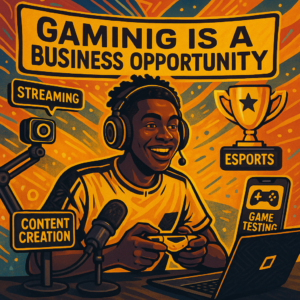Relationships in Esports: The Athlete, the Team, the Tournament Organiser, and the Game Developer

In modern times, esports have evolved from being viewed as a mere hobby and a niche market, into an industry that is globally recognised, a competitive landscape and a sea of opportunities. The key factor in this evolution and the core of this dynamic and ever-evolving ecosystem are the intricate relationships between the various entities involved such as the athletes, the teams, the tournament organisers, the game developers and several other stakeholders.
Establishing and understanding each of these relationships is essential in order to comprehend the full scope of how modern esports functions and develops. This article shall focus on each of these entities and their various relationships in order to highlight their interdependence and significance to the esports market.

The Athletes:
At the very heart of esports lies the athlete, without whom a competitive landscape cannot be created and developed. esports athletes are often young, and highly skilled individuals who dedicate countless hours to training and honing their abilities to compete in specific games. Their relationship with the other stakeholders is crucial to the success of the field and can be outlined as follows:
- With the Team – Athletes are typically a part of professional teams, who provide them with the necessary support in order to compete at the top levels. Teams offer athletes resources such as coaching, strategic planning, infrastructure, physical and mental support, logistical assistance and much more. In return, the athlete commits to training schedules, representing the team’s brand, and competing in tournaments with the objective of securing a victory under the name and brand of the team. This mutually beneficial relationship is needed as while teams benefit from an athlete’s performance and fan engagement, the athlete benefits from the team’s support and sponsorship.
With the Tournament Organiser – Athletes require competitions in which to participate and showcase their skills, which is where the tournament organiser comes into place. Tournament organisers need the best players to compete in their tournaments in order to attract viewership, sponsorships, and more fan engagement. Athletes require well-organised, fair and competitive environments to demonstrate their abilities and further their careers. The relationship between organisers and athletes is also crucial to
- crucial to maintaining a fair set of rules and regulations, ensuring fairness and integrity in competitions.
- With the Game Developer – Game developers create, maintain and update games that the athletes play. This relationship involved a loop of continuous feedback wherein the athletes test the beta-version of games to provide insight into mechanics, balance, and potential issues. Developers will often engage top athletes to help refine games and ensure they remain competitive and enjoyable. In return, athletes help promote games through their own performance, streaming online and through their own social media presence.
The Teams:
Teams are the pillars of competitive esports as their responsibility is to scout and procure talent, bring various talented players together, and provide them with the resources and platforms to succeed. Their relationship with the other stakeholders is as follows:
- With the Athlete – Teams invest heavily in athletes, providing financial support, infrastructure, training facilities, and professional coaching. This relationship is based on interdependence as the team’s success rests on the performance of the athletes and the athletes rely on the team’s support for their own career stability. The athlete-team relationship also extends beyond gaming, involving personal development, community engagement, marketing and other activities.
- With the Tournament Organiser – Teams work with tournament organisers to ensure the smooth participation of their athletes in events. The relationship involves negotiation of the terms of participation, ensuring compliance with the relevant rules and regulations, and potentially collaborating with the organiser on promotional activities. A positive relationship between these two parties is essential for the growth of the industry and the organisation of successful events.
- With the Game Developer – Teams, like individual athletes, often collaborate with developers in order to provide feedback on games, participate in promotional events, test new features and other activities. Game developers may also sponsor teams in order to provide them with early access or exclusive content, solidifying the relationship. Teams benefit from having a direct line of communication with developers, who can influence the balance of games and the nature of competition.
The Tournament Organiser:
Tournament organisers are the creators and architects of the competitive landscape in the industry. They are responsible for organising and managing events, providing a platform for the other entities to develop and grow. The relationship between tournament organisers and the other entities is as follows:
- With the Athlete – For an athlete, it is essential that a tournament organiser ensures a fair and competitive event. This includes the clear communication of rules, providing the necessary information for participation and ensuring the integrity of the competition. Organisers often rely on players, post-events, to receive feedback and foster a trusting and mutually beneficial relationship.
- With the Teams – Organisers rely on teams to participate and fill their event with high-quality athletes and names. In order to attract teams, organisers must ensure to manage logistical aspects of the event such as scheduling, accommodation, and participation of the team. Teams will often work with organisers to promote events, utilising the team’s fan base to further boost event visibility and viewership.
- With the Game Developer – Organisers and developers work hand-in-hand to ensure successful events. Developers require a platform for their games to be played by athletes and displayed for public consumption and organisers require high-quality and competitive games to be played at their events. Tournaments help market and promote games while game developers ensure the competitiveness and integrity of events by ensuring properly balanced games.
The Game Developer:
Game developers are arguably the most crucial entity in the esports industry as without the creation of games to play, there would be no foundation upon which to build the market. Creating new games that attract audiences and maintaining longstanding popular games are crucial roles to be performed by game developers. Their relationship with the other entities is as follows:
- With the Athlete – Game developers support athletes by ensuring a game remains balanced, competitive, interesting with new updates, and free of major issues. In addition, game developers create new games for athletes to play and provide feedback. Developers will also engage athletes in promotional activities so as to market new games to the player’s fan base.
- With the Teams – Developers and teams work together to ensure the competitive scene is vibrant. This can include sponsorship deals, exclusive content, and direct communication channels for feedback and testing purposes. Teams provide developers with high-level players to showcase the game’s potential, while developers provide teams with new games that teams can potentially see competitive success with.
- With the Tournament Organiser – Developers and organisers collaborate together to create successful events that align with the games and their vision. Developers support organisers with funding, technical resources and promotional efforts while organisers provide developers with a platform to demonstrate their games. This relationship is crucial to not only ensure well-organised tournaments but also to enhance the game’s reputation.
The interconnected spiderweb of relations in esports between the athletes, the teams, the tournament organisers and the game developers are deeply ingrained and symbiotic. Each stakeholder herein plays a vital role in the maintenance and growth of the entire ecosystem.
Understanding each of these relationships, and the individual characteristics is essential to comprehend and appreciate the complexity, dynamism and potential of this rapidly growing field. As esports continues to evolve, these relationships will likely become even more critical, with the involvement of new stakeholders and new roles, driving the industry to greater recognition, structure, professionalism and success.
by Swagath Chanila Ramachandra
Junior Associate Parmars





